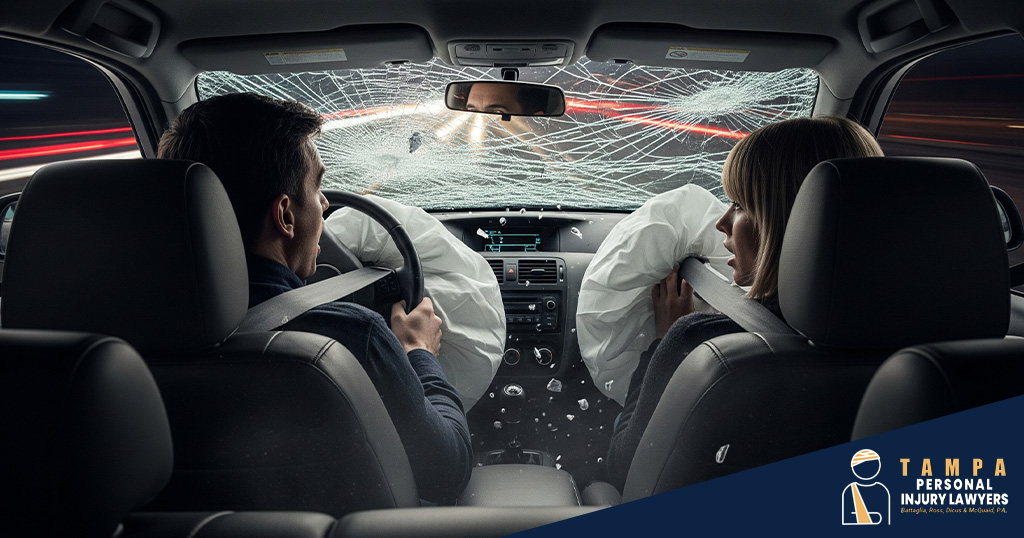Car crash airbags are one of the most important safety features in modern vehicles, but many drivers don’t know exactly when they will go off. Understanding when airbags deploy can be a matter of life or death, as these crucial safety systems have saved tens of thousands of lives. However, when they malfunction or don’t activate during a crash, the results can be devastating. This guide will explain how airbag deployment works, the specific conditions that trigger activation, and what to know when airbags deploy in different crash scenarios. You’ll learn why airbags sometimes do not go off in seemingly serious accidents and what legal options you have if an airbag fails. Knowing when airbags are supposed to deploy can help drivers stay safe and protect their rights after an accident.
Table of Contents
ToggleUnderstanding Airbags: Types and Functions
Modern vehicles are equipped with many types of airbags. These airbags are designed to protect passengers in different kinds of accidents. Each airbag system has a specific purpose based on the direction and severity of the impact. The system’s sensors decide when airbags deploy to provide maximum protection.
Front Airbags
Front airbags are the most common type. They are located in the steering wheel and dashboard, deploying during frontal collisions to create a cushion. This action helps prevent direct and often fatal contact with hard surfaces.
Side Airbags and Curtain Airbags
Side airbags deploy from seatbacks or door panels to protect the torso and head during side impacts. Federal regulations have required them in all new vehicles since 2014. In addition, curtain airbags line the side windows, deploying from above during side impacts or rollovers to shield occupants’ heads.
Knee Airbags
Knee airbags are located in the lower dashboard. They deploy to protect the driver’s knees and legs, helping to reduce lower-body injuries during frontal crashes.
Other Airbag Systems
Some vehicles feature advanced systems like inflatable seatbelts, which distribute crash forces across a larger area of the body. There are also pedestrian airbags designed to deploy externally to cushion pedestrians during a collision with the vehicle.
How Airbags Work: Deployment Mechanisms Explained
Airbag sensors are the first line of defense in your vehicle’s safety system. They monitor movement, measuring how quickly the car slows, the force of impacts, and changes in direction. When sensors detect a sudden change in speed suggesting a collision, they send data to the electronic control unit (ECU) within milliseconds.
The ECU evaluates crash severity, impact direction, occupant presence, and seatbelt usage to decide if airbags should deploy. If deployment is necessary, it sends a signal to pyrotechnic initiators, triggering a chemical reaction that inflates the airbag in 1/20th of a second. The entire process happens faster than a blink, protecting occupants before they hit any interior surfaces.
When Do Airbags Deploy? Deployment Criteria by Airbag Type
Airbags are designed to deploy only when a crash is severe enough to cause injury beyond what a seatbelt can prevent. This is why they don’t go off in every fender-bender. The ECU constantly evaluates crash data to make a split-second decision on when airbags deploy. It considers several factors to determine if a crash meets the specific deployment criteria.
Frontal Airbags
Frontal airbags protect you in head-on collisions, which are common on busy Tampa roads such as I-275 and the Selmon Expressway. Their deployment is based on the force of the crash, not just the car’s speed. For an unbelted occupant, frontal airbags will typically deploy in a crash equivalent to hitting a solid wall at 10 to 12 mph. Understanding exactly when airbags deploy can help drivers anticipate safety outcomes. For a belted occupant, the threshold is higher, at approximately 16 mph, because the seatbelt provides vital initial protection.
Side Airbags and Curtain Airbags
Side and curtain airbags work differently. They deploy much faster than frontal airbags because there is less space between the occupant and the impact point. The deployment speed varies depending on the type of collision. For crashes into a wide object, side airbags typically deploy at speeds of about 18 mph. For a crash into a narrow object like a pole, the concentrated force can cause airbags to deploy at a lower speed, sometimes as low as 8 mph. Side impacts can be particularly dangerous, especially at busy intersections around downtown Tampa. Understanding when airbags deploy and how to respond in these situations can be crucial.
Reasons Why Airbags May Not Deploy in a Crash
Even with advanced airbag technology and strict deployment criteria, airbags do not always deploy as expected. While the ECU’s analysis may determine a crash is not deployment-worthy, a failure to deploy can also be due to a system malfunction or other specific reasons:
Mild to Moderate Crashes
The most common reason for airbags not deploying is that the crash was not severe enough to trigger them. In a low-speed collision where seatbelts are sufficient to protect occupants, the airbag control module may decide not to deploy the airbags at all.
Occupant Detection Issues
Even in a serious crash, an airbag might not deploy if the system thinks no one is there to be protected. For example, airbags in a passenger seat may not deploy due to issues with occupant detection, such as passenger weight and positioning, the presence of child safety seats, or small-stature occupants who fall below a minimum weight threshold. If the sensor doesn’t detect a properly seated adult, it may decide not to deploy the airbag to avoid causing injury to a child.
Previous Crash History and Malfunctions
An airbag can only deploy once and must be professionally replaced after an accident. A vehicle with an unreplaced airbag system cannot deploy again, leaving occupants at serious risk. Furthermore, a sensor malfunction or damage can cause the entire airbag system to fail, as the electronic control unit relies on accurate data. This can lead to a dangerous situation where the airbags do not activate when they are needed most.
For more information on how airbags work and their safety mechanisms, you can refer to the National Highway Traffic Safety Administration (NHTSA) which provides extensive research and guidance on vehicle safety.
Potential Injuries from Airbag Deployment and Safety Considerations
While failure to deploy is one concern, understanding when airbags deploy is equally important, as the force and timing of inflation can affect injury outcomes. Airbags deploy with tremendous force, approximately 2,000 pounds of pressure. They inflate at speeds reaching up to 200 mph in a fraction of a second. This explosive deployment can cause significant injuries. These injuries often occur when occupants are positioned too close to the airbag module during inflation.
Common airbag-related injuries can include:
- Facial injuries like burns and fractures from direct contact.
- Chest trauma such as broken ribs.
- Arm and hand injuries from hands positioned on the steering wheel during inflation.
- Chemical burns from the dust released during deployment.
- Eye injuries from debris and chemical irritants.
Safety Considerations
Proper seating position is critical for airbag safety, as the airbag’s expansion radius is 12-18 inches from the deployment point. To minimize potential injuries, always follow these essential tips:
- Maintain at least 10 inches between your chest and the steering wheel.
- Sit upright with your back against the seat.
- Keep your hands at the “9 and 3 o’clock” position on the steering wheel.
- Position children under 13 in the backseat with appropriate restraint systems.
What To Do If Your Airbags Fail To Deploy After A Car Crash
When airbags fail to deploy during a collision, your immediate actions are critical for your safety and your legal rights. The absence of airbag deployment in a crash that should have triggered them raises serious safety and liability concerns.
Immediate Steps After a Crash
After an accident, the first step is always to ensure your safety and the safety of others. If your airbags did not deploy, take these crucial steps:
- Seek Medical Attention: Even if you feel uninjured, the lack of airbag protection may have caused unseen injuries.
- Document the Scene: Use your phone to photograph the vehicle damage, the interior, and any visible defects.
- Preserve the Vehicle: Do not allow any repairs until a qualified technician has inspected the airbag system.
- Collect Witness Statements: Get contact information and statements from any witnesses.
- Request a Police Report: This official document details the crash and is a vital piece of evidence
Important Note: Regular vehicle maintenance ensures optimal performance of your airbag system. If your airbag warning light was on before the crash, this could be a key piece of evidence in your case, as it indicates a known system malfunction.
Legal Considerations and Product Liability Claims
An airbag failure under appropriate crash conditions may indicate a serious manufacturing defect or a system malfunction, which can result from:
- Manufacturing defects in sensors or deployment mechanisms.
- Design flaws in the airbag system architecture.
- Inadequate testing or quality control processes.
- Faulty software programming in electronic control units.
These failures often lead to what are known as “enhanced injury claims,” meaning victims suffer more severe injuries than they would have with properly functioning airbags. A car accident lawyer specializing in these cases can evaluate whether the non-deployment constitutes a system failure. They will investigate your case and examine the vehicle’s ‘black box’ data, which records crucial information about the crash. Then they determine if the failure to deploy led to enhanced injuries that a working airbag would have prevented.
Proving a product liability case requires extensive technical evidence, and expert witnesses play a vital role. They can analyze crash data and reconstruct the accident to demonstrate how proper airbag deployment would have prevented or reduced your injuries. Manufacturers face significant liability when their safety systems fail to protect occupants during crashes that meet the deployment criteria.
Contact A Tampa Car Accident Lawyer Today
Understanding when airbags deploy can be the key to a successful compensation claim. If you’ve been involved in a crash where your airbags failed to activate properly, it may indicate a manufacturer defect or system failure that could entitle you to compensation.
Navigating the complexities of defective airbag cases, including situations where airbags fail to deploy when they should, requires a trusted and experienced legal partner. When you work with Tampa Personal Injury Lawyers, you get the benefit of an award-winning team with a proven track record, a strong reputation, and extensive resources to help you secure the compensation you deserve.
Don’t let a defective safety system prevent you from getting the justice you deserve. Take the first step by calling our Tampa office now to schedule your free consultation. Let our skilled lawyers help you secure the full compensation you are entitled to.
FAQs (Frequently Asked Questions)
How do airbags work and when do they deploy?
Airbags use a system of sensors that detect sudden changes in speed or direction. This data is sent to an electronic control unit (ECU). If the ECU determines the crash is severe enough, it triggers the airbag to inflate within milliseconds. Frontal airbags typically deploy in moderate to severe front-end collisions, while side airbags deploy in significant side impacts.
Why might my airbags fail to deploy in a crash?
Airbags are designed to not deploy in minor collisions where seatbelts provide enough protection. Failure to deploy can also be caused by sensor malfunctions, previous unrepaired deployments, or crash conditions that don’t meet the system’s specific criteria.
What should I do if my airbags fail to deploy after an accident?
First, seek immediate medical attention. Then, document the accident scene and preserve your vehicle. Consult with experienced car accident lawyers to evaluate your case for potential legal claims related to a defective or malfunctioning airbag system.
How can I maximize my safety with my vehicle’s airbag system?
Always wear your seatbelt. Maintain a proper seating position at least 10 inches from the steering wheel. Regularly service your vehicle and address any illuminated airbag warning lights, as they can indicate a system malfunction.






























